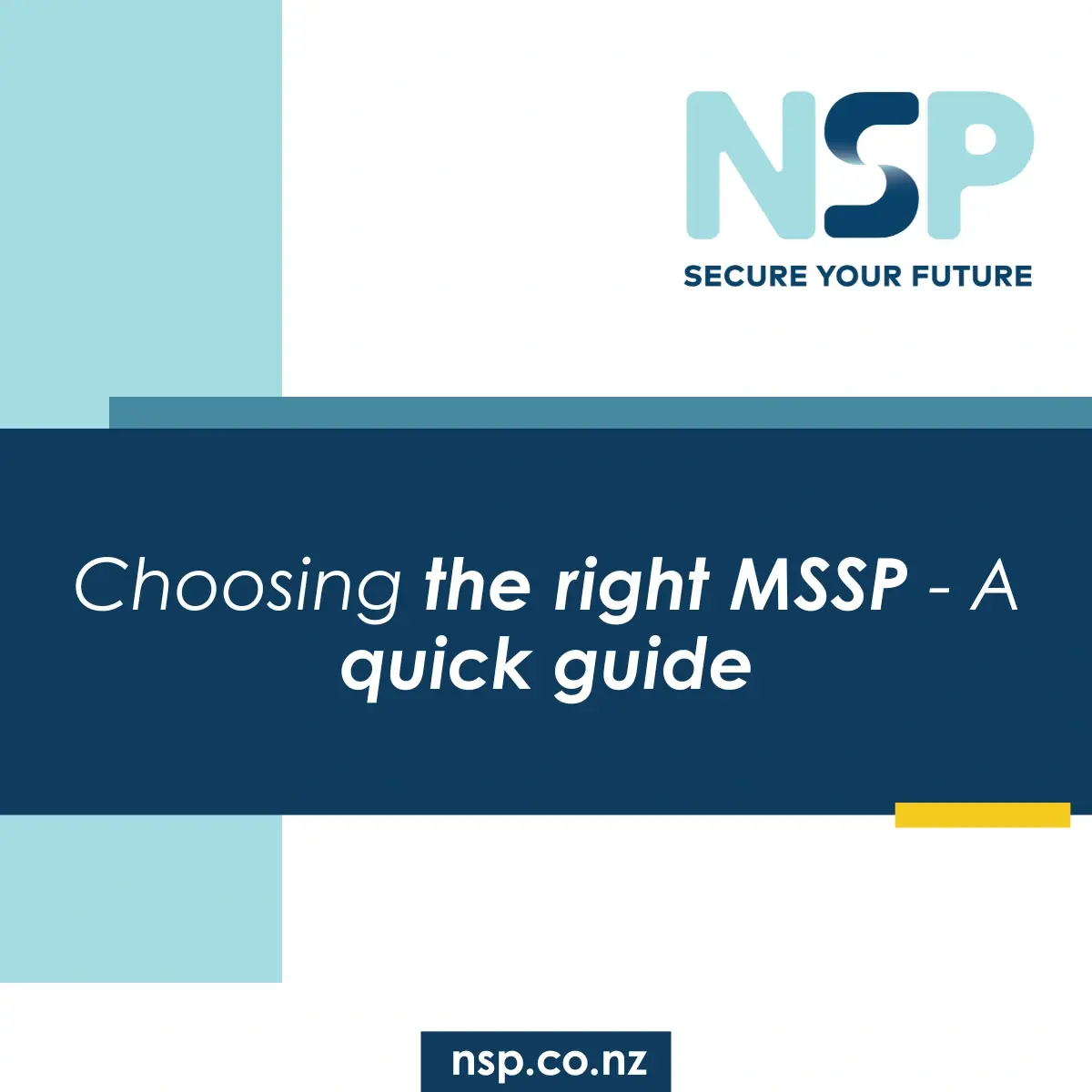Windows 10 End of Life Guide for NZ Businesses | NSP
Dayna-Jean Broeders
29 September 2025
13 min
ReadWindows 10 End of Life: Your Complete Migration Guide for New Zealand Businesses
On October 14, 2025, Microsoft will cease all support for Windows 10, marking the end of an era for the world's most widely adopted operating system. For New Zealand businesses still running Windows 10, which includes approximately 68% of organisations according to recent market data, this deadline represents a critical inflection point that demands immediate strategic planning.
The implications extend far beyond a simple software update. This transition affects everything from cybersecurity posture and compliance requirements to operational efficiency and competitive advantage. Yet despite the urgency, many Kiwi SMEs remain unprepared, either underestimating the complexity of migration or postponing decisions that could impact their business continuity.
This comprehensive guide will provide New Zealand CIOs, IT managers, and business owners with the authoritative insights needed to navigate this transition successfully. We'll explore the real costs of inaction, outline strategic migration pathways, and demonstrate how the right approach can transform this mandatory upgrade into a catalyst for business growth.
Understanding Windows 10 End of Life
When Microsoft ends support for Windows 10, organisations lose access to critical security updates, patches, and technical support. This isn't merely an inconvenience, it's a fundamental shift in your security and operational risk profile.
The Security Reality
Post-support Windows 10 systems become increasingly vulnerable to cyber threats. Without regular security patches, newly discovered vulnerabilities remain permanently exposed. For New Zealand businesses operating under the Privacy Act 2020 and various industry compliance frameworks, this creates significant legal and financial exposure.
Microsoft's historical data shows that unsupported operating systems experience a 3.5x higher malware infection rate within the first year post-support. For SMEs already facing an average of 65 cyber incidents annually according to CERT NZ's latest threat report, maintaining unsupported systems compounds an already challenging security environment.
Compliance and Legal Considerations
The end of Windows 10 support triggers compliance implications across multiple frameworks relevant to New Zealand businesses:
-
Privacy Act 2020 Compliance: Organisations must implement reasonable security safeguards. Running unsupported operating systems could be viewed as negligent data protection practices.
-
Industry-Specific Requirements: Legal firms managing client confidentiality, real estate agencies handling personal information, and educational institutions protecting student data face heightened scrutiny under their respective regulatory frameworks.
-
Cyber Insurance Implications: Many policies now include specific clauses regarding supported operating systems. Unsupported Windows 10 systems may void coverage or increase premiums significantly.
The True Cost of Delayed Migration
Financial Impact Analysis
Delaying Windows 10 migration creates cascading cost implications that extend well beyond initial estimates:
-
Extended Security Updates (ESU): Microsoft offers ESU programs for enterprise customers, but costs escalate annually. First-year ESU pricing typically starts at $61 per device, doubling in year two, and tripling in year three.
-
Incident Response Costs: New Zealand businesses experience an average cyber incident cost of $857,000 according to IBM's 2024 Cost of a Data Breach Report. Running unsupported systems significantly increases both incident probability and impact severity.
-
Productivity Degradation: Legacy systems running Windows 10 gradually lose compatibility with modern software solutions, cloud servprivacyices, and collaboration tools. This creates measurable productivity losses that compound over time.
Operational Risk Factors
Beyond direct costs, delayed migration introduces operational vulnerabilities that can severely impact business continuity:
-
Application Compatibility: Modern software increasingly requires Windows 11 or newer operating systems. Delayed migration can result in forced application updates that create compatibility conflicts.
-
Cloud Integration Limitations: Microsoft's cloud services, including Microsoft 365 and Azure, optimise performance and security for supported operating systems. Windows 10 post-support may experience degraded functionality.
-
Talent Acquisition Challenges: Modern IT professionals expect current technology stacks. Operating legacy systems can complicate recruitment and retention in New Zealand's competitive IT talent market.
Strategic Migration Pathways for New Zealand SMEs
Windows 11 Upgrade Assessment
Windows 11 represents the natural migration path for most organisations, but success requires careful planning and assessment:
-
Hardware Compatibility Analysis: Windows 11 introduces specific hardware requirements including TPM 2.0 chips, UEFI firmware, and specific processor generations. Comprehensive hardware audits identify which devices require replacement versus simple upgrades.
-
Performance Optimisation: Windows 11's enhanced security features and modern architecture deliver measurable performance improvements. However, organisations must ensure adequate RAM (8GB minimum, 16GB recommended) and SSD storage for optimal experience.
-
Security Enhancement Benefits: Windows 11 introduces significant security improvements including enhanced phishing protection, advanced threat detection, and improved identity management integration, particularly valuable for SMEs lacking dedicated security teams.
Cloud-First Modern Workplace Strategy
The Windows 10 end-of-life presents an opportunity to reassess entire workplace technology strategies:
-
Microsoft 365 Integration: Windows 11 delivers deeper integration with Microsoft 365 services, enabling enhanced collaboration, security, and productivity features. This integration proves particularly valuable for distributed teams common in New Zealand's SME’s.
-
Hybrid Work Optimisation: Windows 11's improved video conferencing, virtual desktop capabilities, and mobile device management features align perfectly with New Zealand's hybrid work trends.
-
Scalability Considerations: Cloud-integrated Windows 11 environments scale more efficiently than traditional on-premises installations, supporting business growth without proportional IT infrastructure investment.
Hardware Refresh vs. Upgrade Decision Framework
Organisations must evaluate whether existing hardware can support Windows 11 or requires replacement:
-
Cost-Benefit Analysis: Compare ESU costs, upgrade expenses, and productivity improvements against complete hardware refresh investments. Many organisations find that hardware refresh delivers superior long-term ROI.
-
Business Continuity Planning: Staggered migration approaches minimise operational disruption while ensuring continuous productivity. Prioritise mission-critical systems while planning systematic rollouts.
-
Future-Proofing Investments: Modern hardware investments should consider 5-7 year lifecycles, ensuring compatibility with future operating system updates and emerging technology requirements.
Cybersecurity Implications and Risk Mitigation
Enhanced Threat Environment
Windows 10 end-of-life coincides with an increasingly sophisticated cyber threat environment targeting New Zealand businesses:
-
Ransomware Evolution: Modern ransomware specifically targets unpatched systems. Windows 11's advanced threat protection capabilities provide crucial defence mechanisms unavailable in legacy environments.
-
Supply Chain Attacks: Contemporary attack vectors often exploit operating system vulnerabilities to compromise entire supply chains. Updated operating systems provide essential protection against these sophisticated threats.
-
AI-Powered Attacks: Emerging AI-driven cyber threats require equally advanced defensive capabilities. Windows 11's integration with Microsoft Defender and cloud-based threat intelligence provides crucial protection layers.
Managed Detection and Response (MDR) Integration
For SMEs lacking internal cybersecurity expertise, professional MDR services become essential during this transition:
-
24/7 Monitoring: Continuous threat monitoring ensures rapid response to security incidents during the vulnerable migration period.
-
Expert Analysis: Professional security teams provide contextual threat analysis that internal IT teams often cannot match, particularly during complex system transitions.
-
Compliance Assurance: MDR services help ensure migration activities maintain compliance with relevant regulatory frameworks throughout the transition period.
Implementation Best Practices for New Zealand Businesses
Migration Project Management
Successful Windows 10 migration requires structured project management approaches:
-
Stakeholder Alignment: Engage business leaders, IT teams, and end-users early in planning processes. Clear communication about timelines, expectations, and benefits ensures organisational buy-in.
-
Risk Assessment and Mitigation: Identify potential migration risks including data loss, application compatibility, and user productivity impacts. Develop specific mitigation strategies for each identified risk.
-
Testing and Validation: Implement comprehensive testing protocols using representative user devices and applications. Validate performance, compatibility, and security before full deployment.
Change Management Strategies
User adoption significantly impacts migration success:
-
Training and Support: Provide comprehensive training programs covering Windows 11 new features and interface changes. Consider different learning styles and technical proficiency levels across your organisation.
-
Phased Rollout Approaches: Implement gradual rollouts beginning with power users and IT-savvy employees. Use early adopter feedback to refine deployment processes.
-
Ongoing Support Systems: Establish clear support channels for users experiencing migration-related issues. Quick resolution maintains productivity and user confidence.
Data Protection and Backup Strategies
Migration activities introduce data risks requiring proactive protection:
-
Comprehensive Backup Systems: Implement robust backup systems before beginning migration activities. Ensure backups include system configurations, applications, and user data.
-
Migration Testing Protocols: Test migration processes using non-production systems before affecting operational environments. Validate data integrity and application functionality.
-
Rollback Planning: Develop detailed rollback procedures in case migration issues require reverting to previous configurations. Document all rollback steps and required resources.
Leveraging Modern Workplace Technologies
Microsoft 365 Integration Advantages
Windows 11 migration provides opportunities to maximise Microsoft 365 investments:
-
Enhanced Collaboration Features: Windows 11's deep integration with Teams, SharePoint, and other Microsoft 365 services delivers improved collaboration capabilities essential for modern business operations.
-
Advanced Security Integration: Combined Windows 11 and Microsoft 365 security features provide comprehensive protection against contemporary cyber threats. This integration proves particularly valuable for SMEs with limited security resources.
-
Productivity Optimisation: Modern workplace features including enhanced virtual desktops, improved multi-monitor support, and streamlined application management boost user productivity measurably.
Cloud Integration Benefits
Windows 11's cloud-first design philosophy aligns with modern business requirements:
-
Scalable Infrastructure: Cloud-integrated Windows 11 deployments scale efficiently with business growth, eliminating traditional hardware constraints.
-
Remote Work Support: Enhanced remote access capabilities, VPN integration, and mobile device management features support New Zealand's distributed workforce trends.
-
Disaster Recovery Improvements: Cloud-integrated systems provide superior disaster recovery capabilities compared to traditional on-premises installations.
The NSP Advantage: Expert Windows 10 Migration Support
Navigating Windows 10 end-of-life requires expertise that many New Zealand SMEs lack internally. Network Service Providers brings unique advantages to this critical transition:
Local Expertise with Global Standards
As a New Zealand-based managed services provider, we understand the specific challenges facing Kiwi businesses while maintaining international best practice standards. Our Microsoft-certified engineers have successfully managed hundreds of Windows migrations across diverse industry sectors including legal, real estate, education, and emerging technology startups.
Comprehensive Service Integration
Our migration approach integrates seamlessly with broader IT strategy objectives:
-
Managed Services Integration: Windows 11 migration becomes part of comprehensive managed IT services, ensuring ongoing optimisation and support beyond initial deployment.
-
Cybersecurity Enhancement: Migration activities include implementing advanced cybersecurity measures through our certified security services, providing enterprise-level protection for SME budgets.
-
Modern Workplace Implementation: We leverage Windows 11 migration as a catalyst for broader modern workplace transformation, maximising your technology investment ROI.
24/7 Support and Monitoring
Our round-the-clock support ensures migration activities proceed smoothly without impacting business operations:
-
Proactive Issue Resolution: Continuous monitoring identifies and resolves potential issues before they impact productivity.
-
Expert Technical Support: Direct access to Microsoft-certified engineers ensures rapid resolution of complex technical challenges.
-
Business Continuity Assurance: Our support model prioritises maintaining business operations throughout the migration process.
ROI Analysis: Transforming Compliance into Competitive Advantage
Quantifiable Benefits
Windows 11 migration delivers measurable returns that extend beyond compliance requirements:
-
Productivity Improvements: Enhanced performance, improved user interfaces, and better application compatibility typically deliver 15-25% productivity gains within six months of deployment.
-
Security Risk Reduction: Modern security features reduce successful cyber attack probability by approximately 60% compared to unsupported Windows 10 systems.
-
Operational Cost Savings: Reduced maintenance requirements, improved system stability, and better cloud integration typically reduce IT operational costs by 20-30% annually.
Strategic Value Creation
Beyond immediate benefits, Windows 11 migration creates strategic advantages:
-
Competitive Positioning: Modern technology stacks support business agility, enabling faster response to market opportunities and customer demands.
-
Talent Attraction: Contemporary work environments help attract and retain skilled employees in New Zealand's competitive labour market.
-
Future-Proofing: Investment in current technology platforms provides foundation for emerging technologies including AI integration and advanced analytics capabilities.
Taking Action: Your Windows 10 Migration Roadmap
The Windows 10 end-of-life deadline approaches rapidly, but proactive planning transforms this challenge into strategic opportunity. New Zealand businesses that act decisively will not only maintain compliance and security but gain competitive advantages through modern workplace capabilities.
Success requires more than technical expertise, it demands strategic thinking, careful planning, and experienced guidance. The complexity of migration planning, hardware assessment, security implementation, and user training often exceeds internal capabilities, particularly for growing SMEs focused on core business activities.
Network Service Providers has successfully guided hundreds of New Zealand organisations through similar transitions. Our comprehensive approach addresses technical requirements while supporting broader business objectives including improved security posture, enhanced productivity, and reduced operational complexity.
Don't let Windows 10 end-of-life become a crisis. Transform it into a catalyst for business growth through strategic migration planning and expert implementation support.
Ready to secure your business future? Book a consultation with Network Service Providers today to develop your comprehensive Windows 10 migration strategy. Our Microsoft-certified engineers will assess your specific requirements, recommend optimal migration pathways, and ensure seamless transition with minimal business disruption.
Frequently Asked Questions
1. Can I continue using Windows 10 after October 14, 2025?
Yes, Windows 10 will continue functioning, but Microsoft will stop providing security updates, patches, and technical support. This creates significant security and compliance risks for business environments.
2. What are Extended Security Updates and should my business purchase them?
Extended Security Updates (ESU) provide additional security patches for enterprise customers, but costs escalate annually and only provide temporary protection. Most organisations find Windows 11 migration more cost-effective long-term.
3. Will my current business applications work on Windows 11?
Most modern business applications support Windows 11, but compatibility testing is essential during migration planning. Some legacy applications may require updates or replacements.
4. How long does a typical Windows 11 migration take for SMEs?
Migration timelines vary based on organisation size and complexity, but most SME migrations complete within 2-6 weeks using structured project management approaches and professional implementation support.
5. What happens to my data during Windows 11 migration?
Properly planned migrations preserve all user data and applications. Professional migration services include comprehensive backup systems and data integrity validation to ensure zero data loss during transition.
CATEGORY
- Article (98)
- Cybersecurity (45)
- Cyber Security (39)
- Digital transformation (31)
- Managed services (29)
- Awareness and education (23)
- Cloud (20)
- IT Risk (14)
- modern workplace (12)
- Collaboration (11)
- Cyber Smart Week (11)
- Breach (9)
- microsoft (9)
- AI (8)
- Backup (8)
- Remote Workers (8)
- copilot (7)
- video (7)
- Future of work (6)
- network performance (6)
- Vulnerability Assessment (5)
- Breech (4)
- Business strategy (4)
- Cyber (4)
- Microsoft Teams (4)
- 0365 (3)
- CISO (3)
- Culture (3)
- Best Practice (2)
- Business Goals (2)
- CASB (2)
- CIO (2)
- COVID-19 (2)
- Charity (2)
- Construction Industry (2)
- Feed the Need (2)
- Friction-less (2)
- Governance (2)
- Managed Detection & Response (MDR) (2)
- Penetration Testing (2)
- Tabletop Exercise (2)
- vCISO (2)
- Assets (1)
- Azure (1)
- BYOD (1)
- Christmas (1)
- Co-pilot (1)
- Deserving Family (1)
- E-Waste (1)
- EPP (1)
- Healthcare (1)
- IT budget (1)
- KPI (1)
- Law Industry (1)
- Legal Industry (1)
- Metrics (1)
- News (1)
- Real Estate Industry (1)
- Restore (1)
- artificial intelligence (1)
- case study (1)
- health IT consultant (1)
- health it (1)
RECENT POST
Let’s stay in touch!
Enter your details below to stay up-to-date with the latest IT solutions and security measures.




